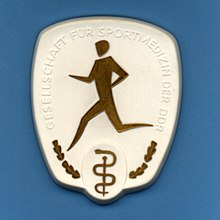Society for Sports Medicine of the GDR
The Society for Sports Medicine of the GDR (GSM) was the specialist organization of physicians who were active or interested in sports medicine in the German Democratic Republic .
history
After the formation of a working group for sports medicine in Leipzig in 1954, it was renamed several times (1956: Medical-Scientific Society for Sports Medicine ; 1958: German Society for Sports Medicine of the GDR ) in 1969 to the final name Society for Sports Medicine of the GDR (GSM). Arno Arnold , an early pioneer of German sports medicine , became the first chairman .
Even if sports medicine in the GDR had the same roots as the German Sports Medical Association, which was re-established in 1950, sports medicine in both parts of Germany soon went separate ways due to the Cold War and increasing isolation. Only the first annual meeting of the society in Weimar in 1955 brought sports medicine specialists from East and West together again. Increasing confrontation also meant that the Society for Sports Medicine of the GDR was only accepted into the World Sports Medical Association, Fédération Internationale de Médecine du Sport, in 1966. In the period that followed, leading sports medicine specialists in the GDR ( Stanley Ernest Strauzenberg and Kurt Tittel ) worked very successfully on the governing bodies of the world association, which was recognized with high awards. Selected sports physicians from the GDR ( travel cadre ) appeared regularly at the FIMS world congresses.
In the structure of the GDR, which was divided into 15 districts, district or regional groups of the GSM were formed, where further and advanced training events took place regularly, which together with courses from the sports medical service led to state recognition as a sports doctor. International sports medical training courses were also commissioned by the World Association for Sports Medicine (FIMS) and carried out in the GDR, which, due to the GDR's sporting reputation, enjoyed great popularity from all over the world. From March 1961, the monthly magazine "Medizin und Sport" appeared, since March 1969 it was published as a joint specialist organ by the Sports Medical Service and GSM.
Up to 1988 a total of 27 annual GSM congresses took place, partly in cooperation with other medical societies and with international participation from the so-called socialist countries .
For achievements and services to the development of sports medicine, the GSM awards the certificate of honor, the honor plaque and the honorary membership . To promote scientific work in sports medicine, there was the award of the Society for Sports Medicine of the GDR . This was financially endowed and was given primarily to young scientists.
In 1989 the GSM had 1,100 full (doctors) and around 300 extraordinary (sports physiotherapists) members.
After the reunification and the opening of the inner German border, independent state associations for sports medicine formed from the previous district groups of the GSM in the future new federal states (Brandenburg, Mecklenburg-Western Pomerania, Saxony, Saxony-Anhalt and Thuringia). The Berlin (East) district group joined the Berliner Sportärztebund (West). The GSM ceased operations in August 1990. At the 32nd German Sports Medical Congress in Munich on October 20, 1990, these new regional associations joined the German Sports Medical Association .
literature
- K.-H. Arndt, H. Löllgen, D. Schnell: 100 Years of GERMAN SPORTS MEDICINE. Druckhaus Verlag, Gera 2012, ISBN 978-3-9814576-4-3 .
- W. Hollmann, K. Tittel: History of the German sports medicine. Druckhaus Gera, 2008, ISBN 978-3-9811758-2-0 .
- SE Strauzenberg, H. Gürtler: The sports medicine of the GDR. Saxonia-Verlag, Dresden 2005, ISBN 3-937951-20-2 .
